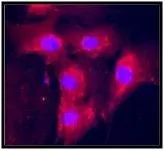VEGFA antibody
GTX22992
ApplicationsImmunoHistoChemistry, ImmunoHistoChemistry Paraffin
Product group Antibodies
TargetVEGFA
Overview
- SupplierGeneTex
- Product NameVEGF antibody
- Delivery Days Customer9
- Application Supplier NoteImmunohistochemistry (formalin fixed paraffin embedded, rodent tissues only): use at a concentration of 5 - 10microg / ml for 30 min at RT. Staining of formalin fixed tissues requires boiling tissue sections in 10mM Tris-HCl, pH 10.0, for 10 - 20 min followed by cooling at RT for 20 min.Neutralising (Int J Oncology, 8:505-511): assay dependent. Optimal dilutions / concentrations should be determined by the end user. Staining of formalin fixed tissues requires boiling tissue sections in 10mM Tris-HCl, pH 10.0, for 10 - 20 min followed by cooling at RT for 20 min.
- ApplicationsImmunoHistoChemistry, ImmunoHistoChemistry Paraffin
- CertificationResearch Use Only
- ClonalityPolyclonal
- Concentration0.2 mg/ml
- ConjugateUnconjugated
- Gene ID7422
- Target nameVEGFA
- Target descriptionvascular endothelial growth factor A
- Target synonymsL-VEGF, MVCD1, VEGF, VPF, vascular endothelial growth factor A, long form, vascular endothelial growth factor A121, vascular endothelial growth factor A165, vascular permeability factor
- HostRabbit
- IsotypeIgG
- Protein IDP15692
- Protein NameVascular endothelial growth factor A
- Scientific DescriptionThis gene is a member of the PDGF/VEGF growth factor family. It encodes a heparin-binding protein, which exists as a disulfide-linked homodimer. This growth factor induces proliferation and migration of vascular endothelial cells, and is essential for both physiological and pathological angiogenesis. Disruption of this gene in mice resulted in abnormal embryonic blood vessel formation. This gene is upregulated in many known tumors and its expression is correlated with tumor stage and progression. Elevated levels of this protein are found in patients with POEMS syndrome, also known as Crow-Fukase syndrome. Allelic variants of this gene have been associated with microvascular complications of diabetes 1 (MVCD1) and atherosclerosis. Alternatively spliced transcript variants encoding different isoforms have been described. There is also evidence for alternative translation initiation from upstream non-AUG (CUG) codons resulting in additional isoforms. A recent study showed that a C-terminally extended isoform is produced by use of an alternative in-frame translation termination codon via a stop codon readthrough mechanism, and that this isoform is antiangiogenic. Expression of some isoforms derived from the AUG start codon is regulated by a small upstream open reading frame, which is located within an internal ribosome entry site. [provided by RefSeq, Nov 2015]
- Storage Instruction2°C to 8°C
- UNSPSC12352203
References
- Effects of Ozone on Injury after Gamma Knife Radiosurgery. Emon ST et al., 2021 May, World NeurosurgRead more

![IHC-P analysis of human angiosarcoma tissue using GTX21316 VEGFA antibody [VG1].](https://www.genetex.com/upload/website/prouct_img/normal/GTX21316/GTX21316_20191203_IHC-P_81_w_23060620_281.webp)

![IHC-P analysis of human liver carcinoma tissue using GTX83425 VEGFA antibody [4G3].](https://www.genetex.com/upload/website/prouct_img/normal/GTX83425/GTX83425_1356_IHC-P_w_23061419_454.webp)
![IHC-P analysis of human breast adenocarcinoma tissue using GTX83426 VEGFA antibody [4E3]. Antigen retrieval : Heat-induced epitope retrieval by 10mM citrate buffer, pH6.0, 100oC for 10min.](https://www.genetex.com/upload/website/prouct_img/normal/GTX83426/GTX83426_1358_IHC-P_w_23061419_344.webp)